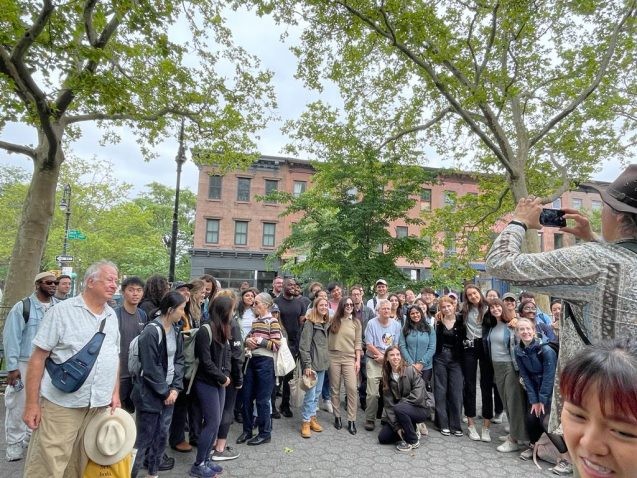Gowanus Canal Visit Offers an Educational Opportunity to Environmental Science and Policy Students
Summer term students took a field trip to learn about the complex environmental, community, and legislative issues at play in this historic Brooklyn neighborhood.
For the past several years, Michael Musso, a lecturer in environmental health sciences and international and public affairs at Columbia’s Mailman School of Public Health, and Steven Chillrud, a research professor in geochemistry at Columbia Climate School’s Lamont-Doherty Earth Observatory, have organized an annual field trip to the Gowanus Canal during the Master of Public Administration in Environmental Science and Policy program’s summer term.
The visit, planned with the help of the Friends and Residents of Greater Gowanus community group (FROGG), provides the students with insight into the impacts of environmental pollution, the resultant community struggles, and the action—or inaction—by local and federal authorities to clean up the canal and its surrounding areas.

The Gowanus Canal is a 100-foot wide, 1.8-mile-long canal in Brooklyn, New York, that was designated by the Environmental Protection Agency as a Superfund site in 2010. Built in the mid-1800s, the Gowanus Canal used to be part of a major industrial transportation route and operated as a waste dumping site by gas and chemical plants and other heavy industry operations throughout the late 19th century, before the Clean Water Act of 1972. Outflows from New York’s outdated combined sewer system also released contaminants from untreated sewage and stormwater runoff into the Gowanus Canal. Despite multiple attempts to clean out the canal over the years, the pollution remains, affecting the lives of the local residents and businesses.
This year, students were divided into four groups, each guided by a different member of FROGG, who shared the history behind the historic pollution of the Gowanus and their experiences fighting it. Throughout the day, the professors, students, and guides discussed the complexity of the situation at the community, regional, and federal levels, as well as the considerations for pollution cleanup. The guides also shared their firsthand experience witnessing the changes and infrastructural development over the years, such as the many industrial complexes along the canal that have been converted into art museums, residential buildings and other land uses.
For the students, many of whom were seeing and learning about the Gowanus Canal for the first time, the field trip was also a welcome break from their intense schedule of summer courses. Christina Morano, an incoming Environmental Science and Policy student, said, “I really liked getting to know the tour guides and having the opportunity to hear them voice their opinions on development in the Gowanus neighborhood. Having a guided tour of the local area, it really helps bring additional insight to what we learned in class.”
Another student, Saiarchana Darira, said, “I found it impactful to learn about the importance of considering the needs of a community when building a canal that neighbors their living space. Gowanus Canal is one of the most contaminated bodies of water in the U.S., yet there is still not enough public knowledge about its environmental health impacts, especially to non-English speaking residents living in the region. It is essential to find cross-cultural ways that transcend language boundaries to communicate with residents, so that communities can make informed consent before living in an area that neighbors a contaminated site.”
The Environmental Science and Policy program was designed to cultivate the next generation of environmental policy makers and environmental science communicators. The annual Gowanus Canal trip, along with the other field trips the program organizes, plays a key role in exposing the students to the issues and injustices, as well as the communities, they will spend their careers advocating for. Columbia University’s collaboration with FROGG allows the students to develop a crucial first-person perspective on how environmental issues like water pollution and unregulated development affect local neighborhoods.
